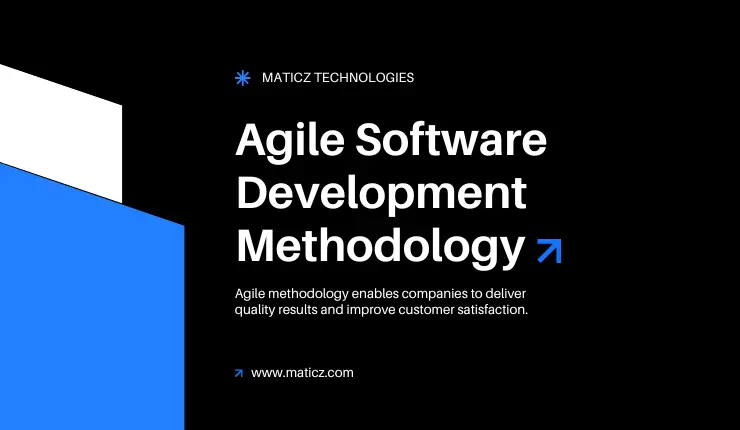Share Posts

What is Agile Software Development Methodology?
63
2211
103
Have you ever felt disappointed about the prolonged project timelines or inflexible development processes? In such a case, Agile Software Development is there to help you. Agile is an outlook that prioritizes flexibility, collaboration, and continuous improvement rather than being an approach or a procedure. Agile methodologies are easily adaptable to changing requirements, ensuring faster delivery of software and it also helps the client involved throughout the process. This approach has entirely transformed the software development process, making it more efficient, dynamic, and client-focused. In this blog, learn how Agile methodology has become the game changer in modern software development.
What is Agile Software Development?
Agile Software Development is a new methodology in software building that concentrates on timely deliveries of short, operational segments known as sprints. Agile, which was established in 2001, is a framework that allows teams to quickly and continuously communicate with their customers. Through this methodology, the plans can evolve based on the real user’s need, thereby fostering close communication between team members, customers, and stakeholders for the alignment of the project.
Agile software development methodology prioritizes people and collaboration over rigid processes, enabling a dynamic workflow where teams can continually iterate on the product and improve it, delivering better software faster, and enhancing user satisfaction. With frameworks such as Scrum and Kanban, Agile is being implemented in practice, making it especially effective in environments that appreciate flexibility and innovation.
Common Hurdles In Traditional Software Development
Traditional Software Development is mostly based on the Waterfall model, which is a linear and constructive approach that has been widely used for many years. This methodology faces several challenges that affect the overall software development's efficiency, adaptability, and success. Below are the key challenges faced by traditional software development.
Inflexibility In Process
In the traditional approach, once each phase is completed it's difficult to revisit as it follows a predefined sequence of steps. This inflexibility leads to several difficulties in case new requirements emerge during the development.
Delayed Customer Feedback
Traditional methods gather customer feedback after the product is been built. This lack of regular feedback during the development process leads to dissatisfaction of the customers with the final product as it didn't meet their requirements and needs.
Long Development Cycle
In the traditional method, each phase can be longer than expected. Due to this prolonged software development, the project might lose its relevance, and also the market opportunities are diminished.
Communication Barriers
Traditional development involves multiple teams working separately on different phases. This raises communication gaps, misunderstandings, and inefficiencies among teams; and thus creates a major impact on the project progress.
Challenges in Adapting to New Change
The inflexible structure of traditional development makes it difficult to adapt to new changes once the project is started because of its constructive nature. Accommodating new technologies or shifting requirements leads to costly rework and completely disrupts the project.
Benefits of Agile Software Development Process
Agile is a flexible and collaborative methodology to develop software. It focuses on adaptability, customer feedback, and frequent, incremental deliveries to enhance the process and to enhance the final product. Below are the core advantages that make Agile the adopted methodology in the contemporary fast-developing environment.
Continuous Customer Collaboration
Customer feedback is gathered regularly in Agile, allowing the software to meet the user expectations at any point. However, continuous collaboration between teams and their customers results in better products with refined ideas based on real-world feedback instead of assumptions early on.
Improved Quality
Continuous testing and integration, finding and fixing issues early in the development cycle, is promoted by Agile. This results in better software (fewer bugs, more reliable features).
Faster Delivery and Iteration
Agile breaks the project into smaller smaller smaller e smaller manageable increments or ‘sprints’ and then delivers functional parts of the software quickly, much like Lego sets. This makes faster releases possible, helping to keep up with market demands.
Flexibility and Adaptability
This gives the ability to make quick adjustments along the process of development. Without constant iterations, requirements are likely to change, and new insights will emerge, making it impossible for the final product to meet current needs.
Enhanced Team Collaboration
This results in communication and collaboration among the cross-functional teams. This not only creates a positive work environment but also engenders all members to offer their ideas, ensuring higher team morale and productivity.
Agile Software Development Process
The Agile Software Development Process consists of five key steps, emphasizing collaboration, flexibility, and continuous improvement to deliver software that effectively meets clients' needs. Here’s what it looks like:
Planning
We start by gathering our team with stakeholders to define project goals and requirements. This initial planning phase involves prioritizing the features and creating a roadmap of how we will approach the project. By getting everyone from the start, we ensure that we all have a common vision.
Design and Development
Once planning is done we move into the design and development phase. We break the project into smaller chunks called sprints, which usually last up to 1-2 weeks. During each sprint our dedicated team works closely together, focusing on specific features and keeping an open communication channel to address any issues that arise.
Testing
Quality is an important key to success, so testing runs in parallel with development. After features are built, we regularly test for bugs and performance issues. In this way, potential problems are caught earlier, and the product we deliver meets our standards before moving forward.
Review
At the end of every sprint, we will have a review meeting where we will present the work done to the stakeholders. This will be a chance to collect inputs and check the progress. Through client feedback, we can make our product conform to meet their expectations.
Release and Retrospective
Once we’ve incorporated the feedback and made the changes we prepare the software for release. After the release, we have a retrospective to reflect on the sprint. This meeting helps the team to discuss what was done and what could be improved, therefore creating a learning and adaptable culture within the team.
By focusing on these steps, we maintain a dynamic and responsive approach to software development that keeps our clients at the heart of what we do. This not only helps us deliver valuable products but also builds strong, collaborative relationships.
Popular Agile Frameworks
Agile frameworks structure an approach for implementing Agile principles and making teams more collaborative, adaptable, and productive. These frameworks exist for all kinds of needs, from workflow visibilities to strict iterative cycle management. Here is an overview of some of the most widely used Agile frameworks below.
1. Scrum
Scrum breaks work down into little sprints (2-4 weeks) that have fixed sizes, and then defines the roles like the Scrum Master & the Product Owner that are responsible. Those tasks like daily stand-ups and retrospectives are used by teams to remain aligned and to continuously improve. It allows us to sort the tasks into priorities to deliver high-value increments. While scrum is designed for teams, it is great for teams that want structure and deliver iteratively.
2. Kanban
With Kanban, there is a focus on visualizing the workflows on the boards which are split into stages like 'To Do,' 'In Progress' and 'Done'. This promotes flexibility, but focuses on continuous flow and work-in-progress, thus limiting work-in-progress to stay efficient. This framework enables teams to find bottlenecks and do real-time workflow optimization. If you’re a team that seeks incremental improvements, Kanban is great.
3. Disciplined Agile Delivery (DAD)
DAD is a hybrid framework that combines Agile, Lean, and more traditional approaches within the full delivery lifecycle. It emphasizes tailoring approaches to specific project needs and introduces governance and scalable strategies for enterprises. DAD makes sure there is disciplined decision-making in balance with structure. It is best suited for large, complex projects.
4. Crystal
Crystal is adaptable and very simple and ensures process tailoring based on team size, project criticality, and goals. It puts great value on communication and teamwork rather than rigid tools and processes. Variants such as Crystal Clear and Crystal Orange fit different team environments. This lightweight nature makes it suitable for small, non-critical projects.
5. Feature Driven Development (FDD)
FDD stresses developing software by breaking the task down into small manageable pieces and then delivering them in increments. The development starts with a detailed project model and has roles such as Chief programmer and Domain Expert for fast execution. FDD guarantees smooth progress, and predictability of outcomes, and it is particularly good for complex, full-of-feature projects.
6. Extreme Programming (XP)
XP enables the development of higher-quality software that is faster and more responsive by practice pair programming, test-driven development (TDD), and continuous integration. It’s about keeping things simple, getting feedback, and shipping often to change. Errors are reduced, and a higher level of efficiency is achieved through automated testing and collaboration environments. Dynamic, fast-paced projects are best suited to XP.
7. Lean Software Development
Lean optimizes workflows in a manner entirely consistent with profitability by eliminating waste and delivering maximum value. It promotes small batch sizes, small batch learning, just-in-time decision-making, and fast feedback for better efficiency. Practices like Value Stream Mapping allow us to discover and fix the bottlenecks. Lean works well with other frameworks and is useful for companies that wish to streamline processes.
Common Challenges and Strategies to Overcome in Agile Software Development Implementation
Agile methodologies are known for their flexibility and adaptiveness, but we can expect some common problems while implementing them. Here are some common challenges and strategies to avoid frequently raised issues.
Unwillingness to Change
Challenge:
Some kind of comfort in the conventional methodologies or practices might prevent the developers from adapting to the new agile software development process.
Solution:
Conduct workshops and educate the team members to get familiarised with agile methodologies, and benefits, and share about successful agile-driven projects to motivate them. Also, ensures great leadership support and creates a safer space for feedback.
Lack of Clear Requirements
Challenge:
Agile Methodologies can manage evolving requirements. However, too frequent requirements might lead to confusion and misunderstandings resulting in the overall project disruption.
Solution:
Make sure to have regular consultations with stakeholders to clarify their requirements & needs. Ensure the team members are aware of the new requirements. Regularly prioritize the backlogs to address the important features first.
Inconsistent Team Performance
Challenge:
Variations in skill level, workload distribution, and motivation are some factors that lead to uneven sprint outcomes and impact the overall team efficiency and morale.
Solution:
Encourage team members to learn new skills and technologies to stay updated. Make sure to distribute the workload among sprints based on their skill sets and capabilities. Utilize retrospectives to know about each sprint and that fosters teamwork as well as performance.
Integration with Other Methods
Challenge:
Implementing other methodologies like Waterfall or DevOps with Agile methodologies, might be too difficult for team members to adapt.
Solution:
Create a tailored approach that efficiently goes well with the agile methodologies without any disruption and make a standard protocol out of it. Ensure that clear communication among teams is a key factor that addresses the major pitfalls and helps to get a standard outcome.
Inadequate User Involvement
Challenge:
Sometimes Stakeholders and users may not be properly engaged throughout the process resulting in uneven features and consequences that might affect the overall project status.
Solution:
Establish a regular schedule with stakeholders for feedback and reviews to meet their needs and also ensure that the challenges are addressed continuously to deliver exclusive products and foster collaborations.
Conclusion
Agile software development allows teams to deliver quality and acceptable software by encouraging collaboration, flexibility, and continual improvement. Frameworks such as Scrum, Kanban, or Lean help the organization respond promptly to changing requirements while ensuring overall customer satisfaction. Each framework offers unique benefits, making it possible to tailor Agile approaches to specific project needs. Agile’s focus on iterative progress and team alignment makes it a preferred choice for modern software projects. Investing in Agile ensures scalable, efficient, innovative solutions that drive success.
Ready to transform your software development process with Agile? Maticz, a leading software development company, specializes in delivering tailored Agile solutions that drive innovation and business growth. Contact us today to accelerate your next project!
Tap Into the Future
The latest insights, posts, and project updates - straight to your inbox.




